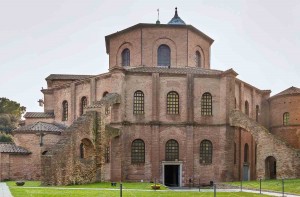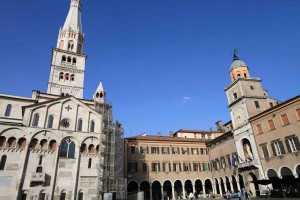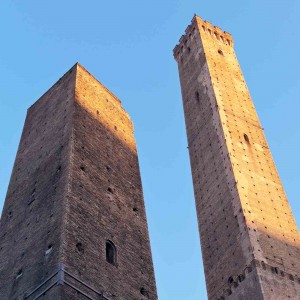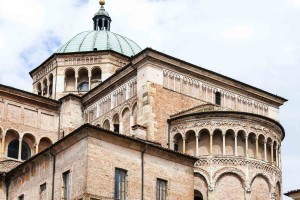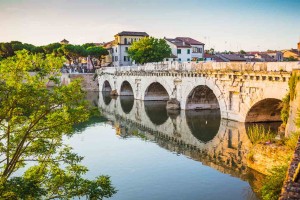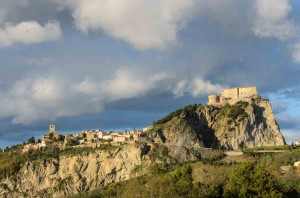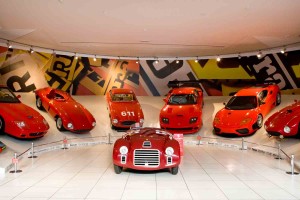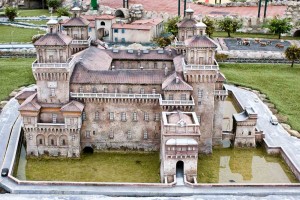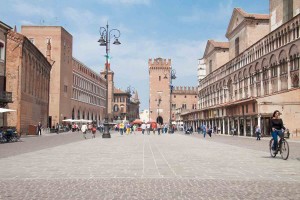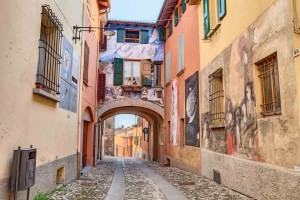Diverse, inspiring and simply beautiful: Emilia-Romagna is one of Italy’s most popular holiday regions. You’ll find an abundance of large cities, quaint beach strips, the green hinterland and great insights into days long gone. You have no idea where to start your journey? No problem! ZAINOO has compiled the 10 best sights of Emilia-Romagna for you. Have fun exploring!
Basilica of San Vitale in Ravenna
Ravenna achieved international fame for its historic mosaics, which can be seen in seven of the eight World Heritage Site buildings. One of those is the Basilica of San Vitale, dedicated to Saint Vitalis. The church reflects Italy’s change in architectural style in Late Antiquity featuring some Byzantine traces. Once the entire interior was adorned with mosaics. Only a few mosaics in the floor, the aps and the presbytery survived the centuries. You need to check out the ostentatious depictions of the imperial couple Justinian and Theodora left and right of the apse altar.
Piazza Grande in Modena
Not only Ravenna features buildings that were declared World Heritage Site by the UNESCO, there are also some in Modena. Piazza Grande, unsurprisingly the pride of joy of the residents, is home to the Romanesque Cathedral of Modena dedicated to Saint Geminianus and Torre Ghirlandia, an 88-metre-high campanile. The front is made from white marble interspersed with the occasional grey and reddish stone. Taking a look inside with fill you with wonder. Marble balustrade, frescos, the atypical footprint with three naves, the magnificent crypt – let’s hope you’ve got enough time to spare!
Bologna’s leaning towers
The only real leaning tower is in Pisa? Think again! Bologna even has two of them: the medieval Two Towers, also known as Asinelli and Garisenda, the city’s landmarks. Named after their respective building families, the duo was supposedly built in the 12th century within a few years of one another. Garisenda, the more leaning of the two towers, had already been mentioned in Dante’s “Divine Comedy”. The numerous holes in the outer wall originate from the erstwhile scaffolding and are nowadays used for repair works.
Parma Cathedral
Like so many other Italian churches, Parma Cathedral, also known as Santa Maria Assunta, was built on the ruins of a former sacred site. Today’s cathedral was erected in the second half of the 11th century and kept in predominantly Romanesque style. The belfry, however, which was added later, is of Gothic nature. Once you enter the cathedral you should look up and marvel at the grand arching fold. The cupola is particularly beautiful. It features a breathtaking fresco by Correggio that depicts the assumption of the Virgin Mary.
Ponte di Tiberio in Rimini
A 62 m long bridge stretches across the river Marecchia in Rimini connecting the historic city centre and the quaint fishing district San Giuliano. Spectacularly enough, this stone bridge dates back to Roman times as construction began under Emperor Augustus and was eventually concluded under his successor Tiberius – in 20 AD! Ponte di Tiberio gloriously survived the last two millennia with its shiny marble facing and the bridge piers with blind windows. It is still open for traffic.
San Leo
The origins of this small village in close proximity to San Marino can be traced far back. There had already been a Roman camp on the exposed rock in the 3rd century BC. Nowadays, this rock is the site of the fortress of San Leo, which once served as a prison for various popes, with its four defence towers. The quaint historic centre magically leads you to the Roman basilica La Pieve and the fascinating cathedral San Leone, which was made from yellow sandstone.
Museo Ferrari
A blissful smile spreads across the faces of motor sports fans all around the world when merely mentioning Maranello. The town in the province of Modena is home of the legendary Ferrari factory and the Formula 1 team of the same name. Museo Ferrari, an entire museum dedicated exclusively to the world-renowned auto brand, can be found only 300 m from the factory. Enjoy insights into the company’s history including a reproduction of Enzo Ferrari’s office and famous red cars spanning across several decades. Trophies, photos and mementos complete this motor sports dream.
Italia in Miniatura
Viserba, a suburb of Rimini, is home to a replica of the Italian boot on an area of 85,000 m² featuring 273 miniature sights from all over Italy and Europe. The monorail Arcobaleno (“rainbow”) runs around the entire park. The fun facilities also include a white-water ride, a parrot park and a science park. You have to check out the replica of Venice’s Canal Grande with 119 buildings. Cross the channel by boat and enjoy some pocket-sized Venice air.
Ferrara’s historic city centre
Ferrara marks a notable exception in all of Italy. It is one of very few large cities without any Roman roots, only blossoming once the lagoons of Po River had been drained. The fascinating historic city centre developed during the Middle Ages and the Renaissance under the aegis of the ruling Este dynasty. Several palazzi and churches are located around the old centre, the Piazza della Repubblica. The outside staircase at the former Este court palace Palazzo Municipale is probably Ferrara’s most famous subject for a holiday snapshot.
Murals in Dozza
Every other year the Italian community of Dozza in the province of Bologna holds the festival of murals. Famous artists from Italy and all over the world decorate house walls with permanent paintings. Walking through this small town presents you with a highly enjoyable mix of various styles as exquisitely colourful works of art from several decades please your eye. The Biennale del Muro Dipinto takes place in odd-numbered years and needs to be checked out. By the way, did you know that no painting ever becomes lost? All pieces of art that were painted on walls that are at risk of wind and weather exposure or collapsing structures find their rightful new home in Dozza’s gallery.
When tradition and modern life clash before your eyes, you will soon realise how fun a holiday in Emilia-Romagna can be. Would you like to learn more about this unique region, its countless sights and hidden treasures? Simply click through the travel guide by ZAINOO and start planning your next tour today!
